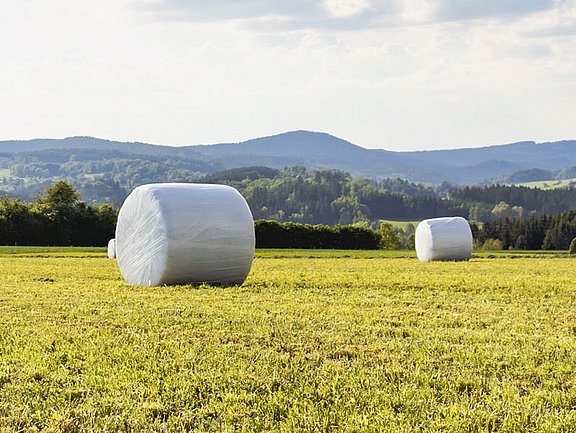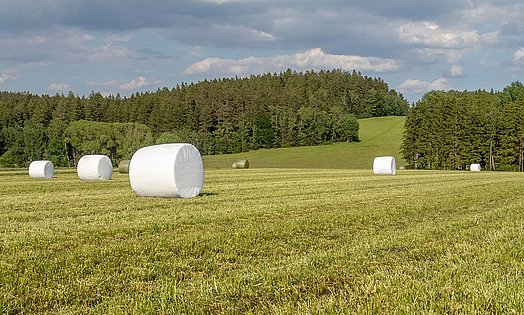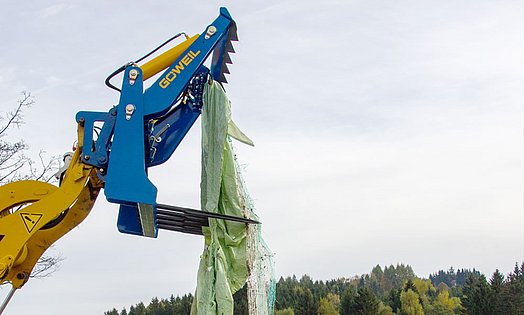The right way to store film
The success of the ensiling process using round or square bales hinges on a variety of equally essential factors: supreme forage quality, dependable harvesting equipment, the careful handling of the finished silage bales and, last but not least: a wrapping film that works reliably every time.
Irrespective of the individual technical requirements the wrapping or wide film needs to satisfy, the proper storage of the film roles play a major part in the trouble-free execution of the work cycle and the successful ensiling process of the precious base feed.
Key aspects for properly storing stretch film used in agriculture
The following is a list of general requirements that apply to the storage of film rolls. Please turn to the respective manufacturers as well and inquire about any special requirements that may apply to your stretch or wide film and follow the instructions given on the pallet stickers or the information printed on the individual rolls / their cardboard boxes.
1. STORE UPRIGHT
The rolls must be stored in an upright position, preferably on pallets and in their original packaging right up to the time of their use. If stored as stacks or in the horizontal position, the rolls may deform or develop an imbalance. This imbalance as well as any possible impact on the edges or damage to the impact-sensitive film surface may result in faults during the wrapping process or render the wrapping film unusable. If the respective manufacture has provided information to that effect on the pallet labels, complete pallets in their original packaging can also be stacked on top of each other.
2. STORAGE LOCATION:
The storage location must be spatially separated from chemicals such as fertilizers, pesticides or mineral oils as these substances will accelerate the decomposition of both the films themselves and the adhesives they contain. While the temperature recommendations specified by the manufacturers range from 5 °C to 40 °C, keep in mind that wide fluctuations and extreme temperatures may affect the films to a substantial degree. For long-term storage, you should therefore avoid areas close to sources of heat and areas where there is a danger of frost in order to ensure that the film layers made of PE plastic are elastic and adhesive the next time you use the film.
3. PLASTIC OR CARDBOARD CORE?
Whether the stretch films you choose have a plastic or a cardboard core is immaterial to storage. The composite cardboard cores are largely resistant to moisture. Other than that, we generally recommend that you store the films in a dry location.
4. UV RADIATION
The UV stability of the film is of paramount importance to both the storage of the rolls and the bale that will later be wrapped with the film. The film rolls should never be stored in direct sunlight to prevent the adhesive necessary for gas impermeability and the adherence of the individual film layers to one another from becoming porous.
Fully wrapped silage bales are supposed to be resistant to UV light for at least 12 months, which is why two summers of storage in locations with a high level of solar radiation might already be borderline and cause the additives used during the production of the film to disintegrate. We therefore ask that you strictly adhere to the relevant specifications provided by the manufacturers.
We also ask that you pay attention to UV stability when picking a repair adhesive tape to fix minor holes or damage to the silage bale.
When choosing a film supplier from the vast pool of manufacturers, you may also want to rely on such national seals of quality as the “NF” in France, the “SP” in Sweden or “DLG-certified” in Germany as they confirm compliance with high quality standards.
If stored correctly, many wrapping films are guaranteed by their manufacturers to remain functional for three or, in some cases, even five years.
Just in time for the start of the season, you will shortly find another article on our website that will provide basic information on agricultural stretch film, its production, subsequent disposal and key properties.
OUTFITTED WITH THE RIGHT TECHNICAL EQUIPMENT FOR THE NEW SEASON?
Click here to learn more about our extensive selection of wrappers.



